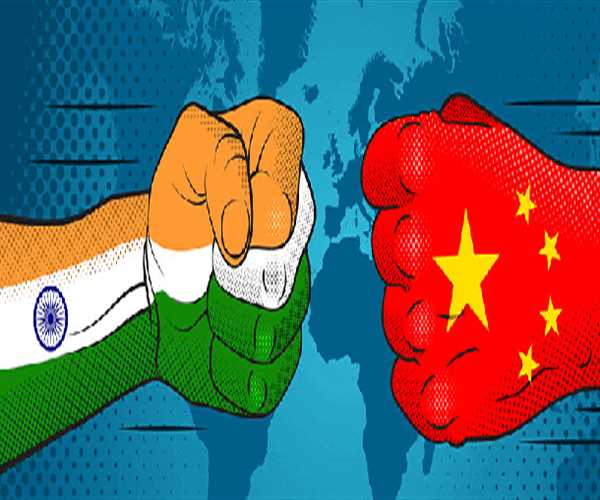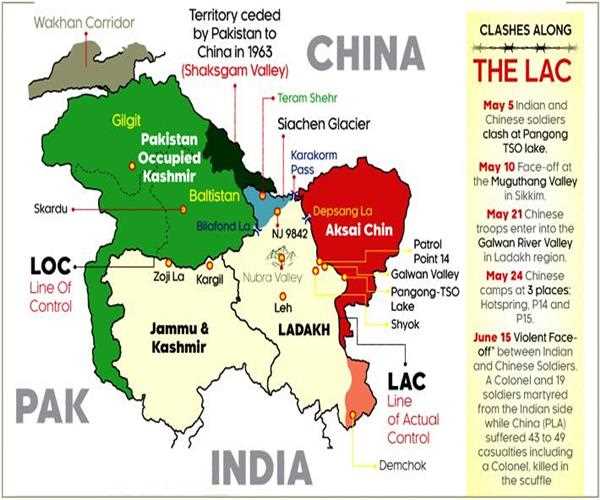Search here

03-Jul-2022 , Updated on 7/3/2022 1:36:58 PM
China’s Development near Indian Border and How it is “A threat to India”?
High in the Himalayas near the frontier with China, India's leader has come to rally the troops. It's mid-2020, and an outbreak of violence with Chinese forces in this remote disputed border zone of Ladakh has shaken the whole of India and left 20 troops dead.
The thing is, China's expansionist ambitions are not over at all. It wants to take real bites out of Indian territory.
Tensions on the border are nothing new. In 1962, they erupted into the month-long Sino-Indian War. Now they're very much back.
The China-Taiwan border dispute is the biggest land dispute in the world right now. The amount of territory that both countries believe belongs to them is more than anywhere else in the world.
The crisis first became visible in May 2020, when many Chinese troops entered various areas in Ladakh. At this moment, nearly 100,000 troops combined from both the Indian and Chinese sides are believed to be deployed additionally on the line of natural control.
India has increased the number of troops stationed in Arunachal Pradesh because China's ambitions go even further here. Arunachal Pradesh is at the eastern end of the Himalayas, bordering China, Myanmar, and the tiny state of Bhutan. This is referred to in the language of border disputes as to the eastern sector. What's special here is that China doesn't just dispute the boundaries; it claims the entire state. What is called 'Southern Tibet.'
In a certain sense, the eastern sector is the most significant because it has the town of Tabang. Tabang was originally a Buddhist town in a part of Tibet. It has got a Tibetan monastery there. They're one of the former Dalai Lama's children. So Tawang remains historically, culturally, and strategically significant for China, which is under India's control.
The idea of a border dispute sounds like a dry technicality, the sort of thing bureaucrats could work out by colouring over maps. But think about what we just heard there. The idea that China sees this region as having historical, cultural, and strategic significance is It sounds like Vladimir Putin's framing of his invasion of Ukraine. This is dangerous.
It is still possible that China will launch a military operation to occupy Arunachal Pradesh, particularly in areas it believes are sensitive for various reasons. Because of its occupation of Tibet and the way it has dealt with other places.
So, as India boosts its forces in Arunachal Pradesh, it's facing a real possibility of war with its superpower neighbour.
So in our consciousness, China is a threat. We have nearly a 4,000-kilometer boundary with them. They keep disrespecting the boundary agreements that we have with them and are not willing to proceed with settling any outstanding issues on that front.

A war between India and China would be between two nuclear powers and two of the biggest countries in Asia, where the Indian army is nearly 1.3 million strong, whereas the Chinese army is nearly 2 million strong. So we are talking about a very big section of the world, a very important part of the world, a very large army, nuclear-armed countries fighting each other.
And crucially, China would have a significant advantage in any conflict.
It's a much bigger power. The Chinese economy is six times India's size. Chinese defence spending is four times India's size. China has more diplomatic power and more global power. It competes with the United States.
The pressure from China is not just being felt on India's borders. It's all across the region.
Beijing has built a deep relationship with India's other problematic neighbour, Pakistan. It's been pouring investment into infrastructure through its belt and road projects, including a massive port on the Arabian Sea, part of a wider strategy that leaves India feeling increasingly surrounded.
The Chinese also had something called the 'string of pearls theory.' So for many decades, they have been putting up bases, especially naval bases, around India to surround India. The Chinese have also, as the world knows, engaged in something called debt-trap diplomacy. Recently, the Sri Lankan economy collapsed because China had extended large amounts of money to Sri Lanka, perhaps through means where they influenced the decision-making process.
The Solomon Islands are very strategically significant. It's understandable that, for China's purposes, they would want to secure a significant foothold and, ultimately, perhaps a major military base in the Solomon Islands. Likewise, as far as Australia is concerned, this is a red line that shouldn't be crossed.
Even far away, Germany sounds the alarm.
China's growing reach across the Indo-Pacific is its top strategic challenge for the US.
China wants to become the hegemon in the region. It wants to displace US power and influence in the region and dominate the economy and political power. It would like to assert its authoritarian ideology throughout the region and be able to dictate the terms that the region operates under.

Their game plan, whether for containing India or for their aggressive actions in the Indo-Pacific, has much larger significance for the whole world. They are taking over countries' economies and their political decision-making powers.
As we've heard, the challenge of China is all-encompassing. So what is India doing about it?
On Independence Day in Delhi, soon after those border clashes in 2020, Narendra Modi gave a rousing address about his response to China's incursion.
TikTok became an unlikely victim of the clashes. India banned the wildly popular Chinese-owned app and dozens of others as part of its retaliatory measures. Two years on, China's Foreign Minister paid a surprise visit to Delhi in March 2022, an apparent attempt to get relations back to normal. But his Indian counterpart said that couldn't happen without China stepping back from the border.
There's been no discussion in parliament; no questions have been entertained in the parliament; there have been no official briefings, and the domestic media coverage of the China border crisis is minimal. There is nothing which is seen in the China border crisis in India.
So, at one level, while we see this major crisis on the border, at another level, we see a desire to underplay the crisis, perhaps because India has a significant weakness vis-a-vis China. And it's a recognition of that weakness that India does not want to push on.
Even after the guns have stopped firing, there is no willingness to talk to parliament. There have been a couple of unilateral statements read on the floor of each house by the foreign and defence ministers. But there was no debate, no responses to questions by MPs. It's been quite disgraceful.

India is sitting back while trade with China booms—on a highly unequal basis. Trade has gone up to almost $100 billion a year, most of which is in China's favour. It's about 80% of Chinese exports to India. In these circumstances, you could see that continuing because it was in China's interest to continue, but not when they're shooting and killing your people. That, to my mind, is where the line had to be drawn.
Everyone has been prepared to give the government the benefit of the doubt because they keep saying, 'We're talking to the Chinese, and the Chinese should push back,' but the Chinese haven't moved back. And, in these circumstances, are we going to sit around temporizing or are we going to look at bigger picture options?
And while India is considering its next moves, Beijing's deepening relations with Moscow will also increase the pressure to shore up India's position.
China will dictate the terms of the Russia-China relationship moving forward. So, India has very little to gain by trying to placate Russia. I think that's a miscalculation on India's part because if things come to blows with the Chinese on the border, there's very little that Russia will be able and willing to do for India.
India needs powerful friends to help it deal with China. And with Russia, the obvious choice is the West. And yet this relationship is complicated. There are significant question marks on both sides.
Also Read Taiwan: Are the US and China heading to War Over the Island

Student
Hello, I am a mechanical engineering student from Delhi Technological University. I've written articles, journals, and social media postings for "Panache"—The Fashion Society of DTU, MindStick Software Private Limited, Zayuche LLP, and OtakuKart. I learned more about the subject through researching it, which has aided my growth.
Comments
Join Our Newsletter
Subscribe to our newsletter to receive emails about new views posts, releases and updates.
Copyright 2010 - 2025 MindStick Software Pvt. Ltd. All Rights Reserved Privacy Policy | Terms & Conditions | Cookie Policy